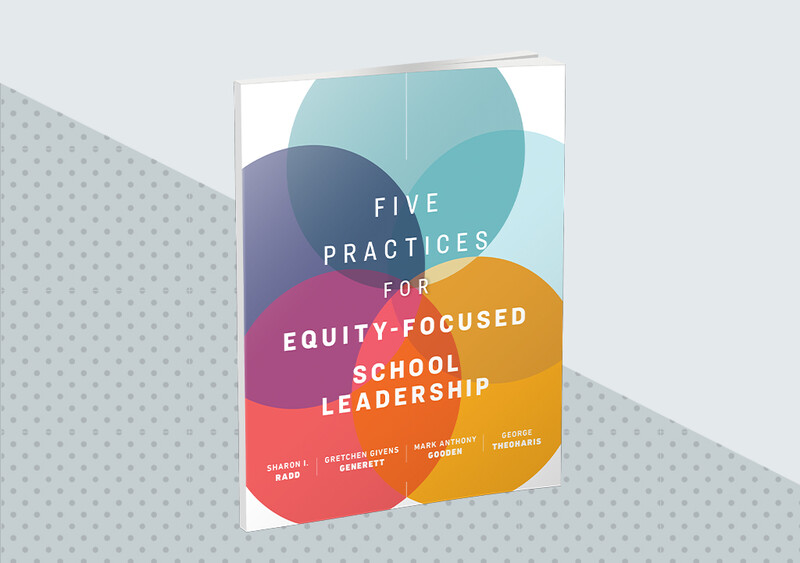Maggie is a white principal, at an elementary school whose population is racially and economically mixed. She is well-respected and committed to educational equity, and— while still learning about equity issues—has long been seen as someone skilled in cross-racial relationships. In this context, Maggie has been known for her skill and fearlessness in constructively engaging with students who display disruptive behavior, and for her ability to “hold the line” with parents, guardians, and caregivers—both privileged and economically marginalized—who push back on any of her decisions.
Then her own children became adolescents and pushed the boundaries at their school in another district. One of Maggie’s children developed several mental health and behavioral challenges around this time. In interacting with this child’s educators, Maggie encountered a school social worker whose empathy and support were boundless, several teachers who were apathetic about her child’s struggles, and an administrator who was rigid and punitive in his discipline. She was discouraged by the difficulties she encountered navigating the different school adults’ approaches to her child. As she continued to engage with her child’s school, Maggie experienced a dramatic about-face in how she thought about her own approach to engaging with parents, guardians, and caregivers. She realized that while her colleagues were grateful when she “handled” parents and guardians, she didn’t like being “handled” by the staff at her kids’ school. She understood how demeaning it can be when school personnel manage a family member rather than partner with them.
Maggie’s interactions at her school changed to reflect the kind of school-family approach she wished administrators used at her children’s school. Rather than “hold the line” against parents, especially those struggling with poverty and similar challenges, she considered how she might stand alongside families, even when their children showed disruptive behavior. Rather than decide for, inform, and teach families, she began to consult and partner with them. She focused on building relationships with all parents, guardians, and caregivers—not just those who regularly showed up at school—and used consistent approaches to gathering input from all involved parties.
The pandemic has highlighted the need for schools to work together with families and community organizations to meet the needs of all learners—especially learners from low-income families. Unfortunately, the state of school-family relationships before and during the pandemic has in most schools been driven by decades-old views of how family-school relationships work best—views that are not inclusive and expansive enough for all families. Of course, many families faced challenges during the pandemic, but we know families living in poverty were impacted by multiple adverse realities simultaneously. The pandemic coupled with job loss and income reduction, lack of childcare options, online schooling, the, and lack of adequate healthcare access, and the racial reckoning are just a few of the social dynamics that exposed fractures in the way school-family relationships work and have even exacerbated existing inequities. This reality may leave some educators with the feeling that families living in poverty need more “handling” now than they did before.
The education field needs a radical paradigm shift in how educators think about and relate with parents, guardians, and caregivers, a shift that will change the way schools connect with families, including those who live in poverty. By paradigm, we refer to “the perspectives through which people view their world and come to understand the activities, items, and relationships within it” (Radd et al., 2021, p. 37). We know from our extensive work with educators that it’s important for each educator—and school—to consider what paradigms might underlie how they currently approach families.
Why Paradigms Matter
Paradigms “act as complex webs of meaning-making that people hold in their subconscious and unconscious mind and that operate and influence them at all times” (Radd et al., 2021, p. 37). Why do the paradigms that educators hold about families—especially families who are economically disadvantaged—matter? Consider these realities, which we’ve observed through our engagement in schools and with related communities and verified through research.
The most common conception of “parent involvement” is one in which a parent or family member is expected to come to the school to receive information and/or donate their labor via volunteering (Barger at all, 2019). This way of becoming involved isn’t possible—or necessarily desirable—for all families.
Adult family members who are not present in schools are often seen as uninvolved in their child’s education, and even as not caring about it or incapable of adequately supporting it.
White middle- and upper-class parents/guardians/caregivers have a disproportionate influence in their children’s schools (Cucchiara &Horvat, 2009).
Parents and caregivers who donate many hours to volunteering in classrooms, the PTA, and fundraising often end up with undue influence with school administrators and teachers. Many use that influence in ways that benefit their own children while directly or indirectly disadvantaging students and families of color and those with few financial resources. Referred to as “opportunity hoarding,” this phenomenon has been well-documented over the last 25 years (see for example, Kelly & Price, 2011; Lyken-Segosebe & Hinz, 2015).
Despite long-standing awareness that schools should communicate with families in their home language, many schools fail to allocate the resources to do so. This leaves families and their students without adequate information to take full advantage of opportunities at the school. In turn, this results in school personnel seeing these families as uninvolved and uninterested in their child(ren)’s education.
In addition, our experience has shown that in schools with disproportionate numbers of families living in poverty, the school as a whole often sees a need to dictate how family members should be involved in their child’s education and to enforce that model of family involvement. The school may even resist or reject family members’ efforts to revise those terms. For example, schools may require parents or caregivers to come to school for regular conferences, and some parents or caregivers may find it works better to support their child’s education by conversing with their child about what they learned and perhaps talking to the teacher by phone—yet the school won’t relax the conference requirement.
While more expansive and inclusive ways of viewing “parent involvement” have been around for decades (see, for example, Delpit, 1995; Jeynes, 2014), many schools remain stuck in limiting paradigms of family involvement that exacerbate inequities. Specifically, many schools continue to hold the belief that families with fewer economic resources are less interested in—or capable of—helping their children succeed than are economically stable families. Often, they approach families who live in poverty more to “help” than to join forces).
To consider whether educators you work with—or you yourself—ever fall into these limiting paradigms, ask yourself whether you believe some parents/guardians/caregivers do a great job supporting their students while others choose not to. Or that some caregivers just aren’t capable of adequately supporting their students. Do you hear language in your school suggesting some students excel because they have great family support and others struggle because they don’t have the necessary parental support? Have you ever found yourself thinking of some families as “good families” and expressing negative judgments of other families?
When educators view families as true and equal partners... they inevitably improve how they interact and build relationships with families.
In contrast to this paradigm, our work has shown that when educators view families as true and equal partners, regardless of the families’ circumstances, they inevitably improve how they interact and build relationships with families. That improvement ultimately supports students in their learning. To help more schools achieve that end, we offer a new paradigm for school-family relationships, in which school and district personnel take leadership in developing mutually beneficial partnerships. In this paradigm, both parties not only hope that particular needs they have can be satisfied by their partners, but also recognize that the person they are collaborating with (whether caregiver or educator) has resources and wisdom to share.
We call this way of thinking about family-school relationships an equity-focused partnership paradigm. The heart of this paradigm is developing true collaboration with families to support and nurture students. Building equitable partnerships with families may require a substantial shift in how a leader thinks about themselves and the school’s role in relation to families. School-leader qualities conducive to true partnership-building include being asset-oriented (they focus on the strengths of students and their families); culturally flexible and inclusive; focused on mutuality (working with caregivers as capable partners also invested in reciprocal relationships); and supportive and authentic (they make accessible paths for families to engage with the school in ways that suit each family and support partnering by showing their human side). Like all good leaders, school leaders in an equity-focused partnership must be empathetic and compassionate in their view of, and interactions with families, and “conflict competent.”
Since paradigms fuel behavior, let’s look at shifts schools can make to more authentically partner with all families.
Four Paradigm Shifts to Achieve an Equity-Focused Paradigm
1. Shift how you reach out.
If you want different outcomes, engage in different ways. Earlier paradigms of family and parent involvement—and even the notion of who is a “parent”—are often not inclusive enough. Actions resulting from these paradigms, particularly in terms of communication and outreach, don’t serve many kids, families, or schools in the most important ways. We must think and act in new, more inclusive ways. For example, when the school or school leaders reach out to family members, have a no-excuses policy to communicate in families’ home languages. If your communication is not in the family’s language, chances are, it isn’t actually communicating your message. Whether it requires translating an email going out to all families or using a translation service to make a phone call to one parent, prioritize finding a way to use the student’s/families’ home language.
2. Focus on assets and opportunities to learn from families.
School personnel should enter and maintain their relationships with families embodying a “learning and partnership” attitude. Step back from being the person with the answers and remember you can learn as much from each family as they can learn from you. For example, family members can help you understand their child and their family’s beliefs, as well as valuable information from their professional and personal experience. This kind of knowledge can help you connect more deeply with your students, and when you connect better, the learning goes better.
Step back from being the person with the answers and remember you can learn as much from each family as they can learn from you.
Even when a family who lives in poverty experiences unusual stresses or trauma, we can choose to see the strength in their coping and aim to see them as partners in their children’s learning. These views will change the way we talk. Let’s stop saying things like, “the school is the safest place some of these kids have” or “the teacher is the most loving person in their lives.” It’s important to not assume that people experiencing poverty are incapable or irresponsible, an attitude promoted in the media and easy to fall into at times for people who haven’t experienced poverty. School personnel who strive to learn from families often come to appreciate a wider variety of forms of “family engagement,” realizing that when a family reads with a child, ensures their child completes homework, attends cultural celebrations, or any number of activities when family members engage with one another, they’re contributing to their child’s learning and development. Challenge yourself to regularly and critically consider whether you truly see each parent/family/guardian as equal to you (a prerequisite for real partnerships), even if their circumstances might be quite different from your own.
3. Use your power to ensure families have voice.
It can be easy to forget how much power you hold as a school leader. Be careful not to lord that power over your school community. Remain aware that you are in a position of influence as a school leader and seek to share power in as many ways, at as many times, as possible. Aim to notice each use of your power and be intentional in using your position in ways that invite inclusion and focus on equity. Use decision-making processes that allow for wide involvement from families, so families inform the outcomes. For example, when considering school improvement goals, have multiple ways of collecting information from families with a range of experiences and perspectives. Check in with families who might be interested but might not be able to attend an in-person meeting and make your school improvement goals available in languages other than English.
4. Don’t mistake material need for personal deficits.
Our society is rife with negative judgments of people who experience poverty. Such judgments are in play when people with means want to give food or other goods to someone asking for money, as if, rather than trusting that person’s judgment, they know for certain the requester would use money for irresponsible purposes. We also see this when people suggest financial literacy classes for people living in poverty, when research shows people living in poverty are often skilled, creative money managers operating in systems stacked against them (Shah et al., in Ehrenfreund, 2016). Find ways to support families with their material needs while still seeing them as capable, ethical people. Devise truly connected ways of supporting your school’s families and the surrounding neighborhood, such as collaborating with community agencies to offer what families identify as their most pressing needs.
Habits For Leaders Modeling an Equity-Focused Paradigm
School leaders seeking to create equity-focused partnerships with families can practice several habits to foster strong, constructive relationships with their new partners--habits that will help these relationships grow and endure in the face of challenging situations or conflict. Going back to our hypothetical example, we’ll illustrate how Maggie adopted some of these habits.
Make relationships a top priority: The partnerships your students need for you to develop cannot happen unless you make relationships a top priority. Make time to be present in conversations, to be available to families, to listen well and patiently. Share information early, often, and thoroughly. Maggie did this when she took the time to listen—really listen—to families when they approached her with concerns and frustrations. They came to know she was sincere in her efforts and became willing to share more openly and consistently.
Assume best intentions: Believe that family members want the best for their child(ren) and assume they’re striving to do and be their best. Remember, each family is sending you the best child(ren) they have—and that raising kids is incredibly hard work! When Maggie experienced negative judgments from her children’s school, she painfully felt how difficult that made it to help her children thrive in school. She realized she didn’t want to perpetuate a judgmental approach toward the families in her school.
Share personal and professional stories: Make space for everyone in the school community to share their stories in ways that foster connection, understanding, and increased knowledge of one another. Avoid assuming that your story is the same as someone else’s story--or that someone else should make meaning of their experience in the way you have. Take the risk of sharing your own story (leaders go first), while also engaging with families to center their stories in the school's work. Maggie created structures for storytelling by having her leadership team and staff engage in reflections on social identity and culture, as recommended in Five Practices. She developed ways to share those stories with families in the school to create a more relatable, connected feeling between school staff and families, and open spaces for families to share their stories.
Engage in conflict constructively: Avoiding conflict altogether weakens relationships—but working through conflict strengthens relationships and improves the way we work together. Empathize with the emotions involved in conflict while striving to understand the underlying points of difference—and find mutually beneficial solutions. Maggie’s most significant shift with parents and caregivers in this regard was valuing their perspectives and goals as much as her own.
Strive for hope-filled interactions: Hope and action have a symbiotic relationship and sometimes we have to choose to start with hope. Learn to focus your interactions on students’ strengths and notice and appreciate the assets students and their families bring to their education. Have empathy for the challenges of living in poverty and seek to develop a realistic understanding of what these families may need. However, avoid toxic positivity, pity, and urges to fix or offer solutions. Listen carefully to what families want and need and trust them to know what’s best for themselves. Maintain hope—for yourself, the families, and their students—that each child will succeed.
Energizing and Equity Supporting
As she shifted toward consulting and partnering with families deliberately, Maggie found this approach supported the school’s equity work in unexpected ways. Through surveys and other forms of data collection, she asked about values, priorities, and challenges; she also collected ideas for solving a wide range of the problems the school and its community faced. Families who in the past had found it difficult to participate in school activities due to lack of transportation or language access were offered accessible ways to participate—and did so comfortably and fully. Teachers learned more about and from the families and came to value the myriad ways families support their children’s learning.
Shifting one’s paradigm on family engagement is challenging, long-term work. Fortunately, taking action to engage in new, more mutual ways to be with families is life-giving and energizing. Ultimately, it creates better outcomes for students.
Authors note: “Maggie” is a composite drawn from school leaders we’ve worked with, and these anecdotes about her work are hypothetical, also drawing on our experiences in schools.
Leading for Equity
The practices outlined in this guide can help school leaders disrupt the status quo, transforming inequities in education into opportunities for full inclusion and academic excellence for every student.










